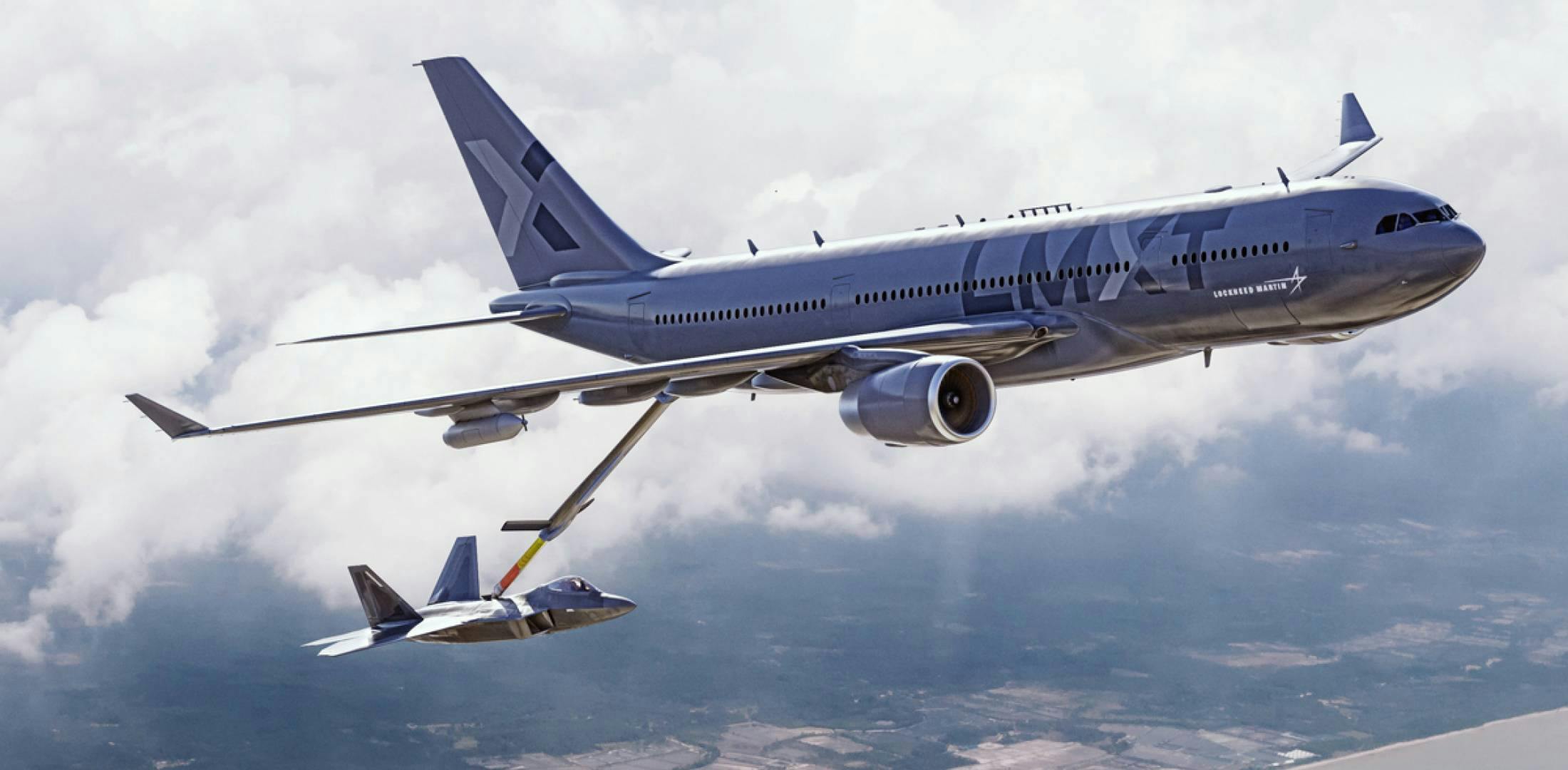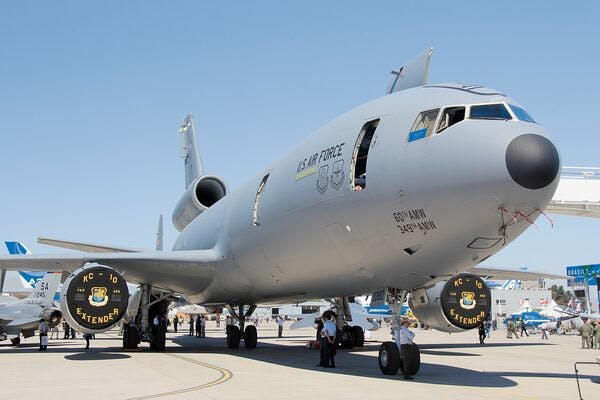Overview of the USAF’s KC-Y / KC-Z next-gen aerial refueler

Blog
The new hotness in aviation is electric flight, but it’s going to take a little time before the technology catches up to the real-world needs of civilian and military aviation. Just as electric ground vehicles have a hard time competing apples-to-apples in some areas of transportation infrastructure built over 120-plus years on fossil fuels, there is currently no realistic substitute for jet fuel and avgas that can meet the requirements of larger scale civilian air travel and military applications.
Times are indeed changing, and new technology is in the works, including major efforts in electrification. But in the meantime, keeping the free world’s eyes in the sky during peacetime, and a large fleet of badass fighter jets, bombers, electronic warfare assets, directed energy platforms, and surveillance aircraft airborne in times of conflict, requires several million metric buttloads of tasty, liquid hydrocarbons. (Fun trivia fact: the US Air Force consumes roughly 2 billion gallons of aviation fuel annually.)
That’s where aerial refueling/tanker platforms such as the KC-135 Stratotanker, the KC-10 Extender, the KC-46 Pegasus, and their potential replacement (currently termed the KC-Y or KC-Z) come in. Let’s get you up to speed.

The need for a next-gen aerial refueler (KC-Y/KC-Z)
The US military is constantly balancing the practical need to stay at the forefront of technological capability against budgetary constraints and political pressure. The Department of Defense has approved massive upgrades to the US’s Ground Based Strategic Deterrent system (GBSD), 6th-gen fighter aircraft (NGAD), Future Long Range Assault Aircraft (FLRAA), Future Attack Reconnaissance Aircraft (FARA), Airborne Early Warning & Control (AEW&C) aircraft, and more, but the USAF has come under pressure in its requests for a next-generation aerial tanker aircraft capable of meeting the needs of current and future aircraft refueling.
As recently as June 2021, the USAF was launching a bid process for the KC-Y aircraft, intended to bridge the gap between the current KC-135s, KC-10s, and KC-46s in service, and the future KC-Z refueler. Per Air Data News, “The KC-Y program is considered a transitional aircraft until the Advanced Air Refueling Tanker project, know (sic) as KC-Z, advances. The US Air Force is considering ordering an unmanned aircraft that can use stealth to enhance its survival in a conflicting environment.”
An unmanned, stealth-capable aerial refueling tanker sounds totally bitchin’, and it may eventually come to pass. But with the current fiscal crisis and the resulting budgetary pressures, the USAF has begun to reconsider the need for a traditional “competition” to determine a replacement fueler, and has, over the past year, begun to recognize the benefits of an upgraded KC-46A. This could potentially replace the “interim” fueler entirely, and bridge the gap between current and future aerial refueling needs.
As Defense News reports, Air Force Secretary Frank Kendall “told reporters in a March that studies into what the Air Force will need for its future tanker led it to start reconsidering whether a competition is necessary. The requirements for this tanker ‘started to look like a modified KC-46, more than they do a completely new design.’”
Air & Space Forces Magazine reported that Chief of Staff General Charles Q. Brown Jr. “somewhat” agreed with Kendall, saying that the KC-46, “tweaked” with upgrades, can likely do the job. “‘I do somewhat agree with him,’ Brown said. Going through ‘the developmental piece’ of a new approach to the KC-Y ‘may take more time [and] more money,’ and this outlay is probably unnecessary because the KC-46, despite its deficiencies, ‘is doing fairly well,’ Brown said. He added that in most scenarios, the KC-46 provides a better than one-for-one capability replacement for the KC-135.”
The KC-46 had a somewhat shaky start, due to USAF reports of aircraft repeatedly being delivered with foreign object debris found in the fuel tank, and the fact that, as delivered, the fueling boom setup was only compatible with an estimated 70% of future aircraft needs.
However, improvements in processes and modifications to the aircraft have changed people’s minds about the operational capability and economical impact of the KC-46A.
USAF acquisition chief Andrew Hunter said, “There’s been a huge sea change in the last year, and Air Mobility Command has really cleared the way for operational use of the KC-46.”
In fact, as of summer 2022, the KC-46 has been approved to refuel 97% of the aircraft flown on US Transportation Command missions.
As improvements and adaptations are made, the case for ordering more KC-46es rather than spend that money on a KC-Y competition begins to make even more sense. A year from now, Hunter predicted, the USAF will have a “very robust and operationally viable KC-46.”

Do more with less: USAF wants to lower the number of aerial tankers required
But the KC-46A-cum-KC-Y will have to do more than just act as a functional placeholder for any forthcoming KC-Z refueler. Defense News cites Secretary Kendall’s plan to ask Congress for permission to cut its tanker fleet requirement from a minimum of 479 refueling aircraft to 455. This means that each tanker will potentially need to step up and cover more than a typical operational load, particularly if there are unforeseen escalations in need during a conflict.
Generally, asking Congress to spend less money is a slam dunk, but there are concerns that reducing the fleet would leave some potential holes in aerial refueling capability. Kendall isn’t too worried, and said, “a tanker capacity of at least 455 would be ‘adequate’ to respond to a threat from China, which the military considers the United States’ current pacing challenge, as well as other missions. But as the Air Force closely considers its priorities in a tough fiscal environment, the service ‘can’t do everything all the time.’”
Since the stated minimum of 479 tankers was based on a 2019 projection including increased potential needs relating to conflicts at the time, it makes sense that it might need to be adjusted based on current forecasts.
But, like any good warrior/politician who knows how to hedge his bets, “Kendall warned the service’s ability to respond to multiple major crises at once may be tested.”
In the meantime, the Air Force has announced that its analysis of alternatives (AOA) for the next-gen KC-Z program will start ahead of schedule in 2024. Original plans had the AOA slated for sometime in the 2030s, but since a competition for the KC-Y is looking to be increasingly unlikely, the USAF sees the need to bump that future-tanker development forward to meet perceived needs.
These are indeed interesting times, and we’re excited to see the next developments in renewable energy-based flight. But until a practical, high-speed aerial battery charger comes online, we’ll likely need to rely on the KC-46A and the KC-Y/KC-Z program to ensure our fleet of dinosaur-burners has enough to drink.
–By Jeff Davis, Intergalactic Scribe
Sources:
https://www.airforcemag.com/requirements-kc-y-fall-analysis-of-alternatives-kc-z-2024/